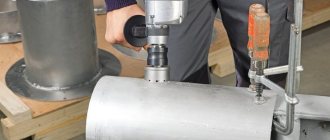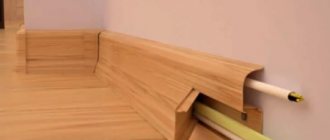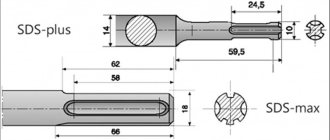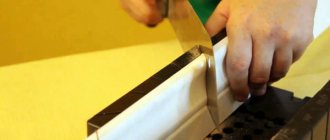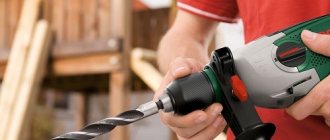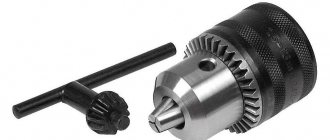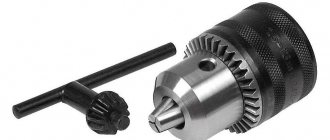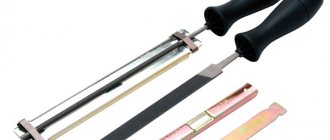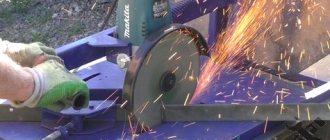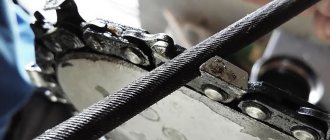Signs that the drill is dull
Before sharpening the drills, you need to make sure that they are actually dull. What signs does this show:
- the cutting tool gets very hot;
- metal shavings flying out from under the edge have a fine fraction;
- the noise of operations increases.
We especially note the last sign, because the friction force between the dull edge of the drill and the plane of the workpiece increases. Therefore, as soon as there is an increase in noise during drilling, work must be stopped immediately. If work is not stopped, the cutting tool will overheat greatly, the structure of the metal will change, which will lead to the complete loss of the tool. After which there is no point in sharpening it.
Edges and rear planes of an overheated drill Source podshipnik-servis.ru
How to choose a drill
Before deciding how to sharpen a drill correctly, I would like to dwell a little on the cutting tool itself.
Let's start with the fact that drills on the construction tools market are presented in a fairly wide range. Since we are only interested in metal equipment, it should be noted that there is a choice here too.
First, you can select by tool color:
- Black is an oxide film, the function of which is to protect the base of the drill from corrosion and high temperatures. Therefore, this variety has high strength and wear resistance.
- Gray – this tool can easily be classified as low quality equipment.
- Bright golden. This color indicates only one thing – the steel from which the tool is made contains titanium.
- Dark golden. The same as the previous option, only there are no internal stresses inside the steel rod. Hence its high qualities.
Types of metal drills Source rozetka.com.ua
It should be noted that most metal drills are rods made of tool steel. But to increase their cutting performance, you need to strengthen the cutting edge. Therefore, today you can buy four types of equipment with different coatings:
- Still the same black oxide film.
- TiCN is titanium carbonitride.
- TiAIN is titanium aluminum nitride.
- Titanium nitride itself.
- Ceramics.
Attention! The last two coatings cannot be re-sharpened.
Mainly in everyday life, and many craftsmen use twist drills to drill holes in metal. This is a steel cylindrical rod in which grooves are cut in the form of a spiral. Hence, in principle, the name.
The smaller part of this tool is occupied by the shank, which is clamped in the chuck of drilling equipment or in a drill or hammer drill. The main part is occupied by a cylinder with grooves. Grooves are cut for one purpose - to create a space through which metal shavings will leave the drilling site without interfering with the main process.
Twist drill: its parts and elements Source studfile.net
Spiral equipment also has a small classification, where there are three positions:
- Classic drill.
- Left-handed. It is used when it is necessary to drill out a broken fastening element from a hole: a bolt, a screw, etc.
- High precision. If the task is to drill a hole with minimal errors, then use it.
So, having sorted out the assortment of equipment, we move directly to the main question - how to sharpen a drill for metal.
How to sharpen?
Strong creaking and heat generation indicates that the cutting tool is worn out. It is worth noting that an increase in temperature leads to an acceleration of the wear process. When considering Pobedit drills for metal, the cutting edge is made of hard alloy, you can sharpen it with your own hands only when using special equipment.
To sharpen pobedit drills with your own hands, you will need the following:
- Grinder. Without such equipment, turning will not be possible.
- When looking for a sharpening machine, it is worth considering that it must have a cooling bath for the stone used. You can create it yourself. The process of processing carbide involves a strong increase in temperature.
- Diamond stone.
We advise you to study - Clinker bricks - characteristics, varieties, sizes and areas of application
A distinctive feature of sharpening carbide material with your own hands is the need to use a diamond stone, since a regular one will not work.
Before sharpening, you should check the possibility of sharpening. If the soldering is less than 10 millimeters, then sharpening with your own hands is basically impossible. Also, large defects do not allow sharpening.
Drill sharpening geometry for various materials
After checking the condition of the tool and if you have the necessary equipment, you can sharpen it yourself. Its features include the following:
- The higher the hardness of the material being processed, the lower the rotation speed of the stone should be. This is due to the fact that increasing the speed of rotation of the stone will lead to rapid heating of its surface.
- The work needs to be done with small touches. It is worth remembering that removing the soldered alloy layer when using a diamond stone takes place quite quickly. Therefore, the master must carefully monitor the process in order not to remove an extra layer of the working surface. The work is carried out overhead, without emphasis.
- When doing the work with your own hands, without using a template, it is recommended to sharpen the surface in the same way as in the case of small drills for metal, when the rear plane is changed.
- It is also recommended to sharpen the front surface. It is recommended to perform this work if the soldering is completely worn out. Such a change should be made so that the thickness of the central part of the soldering is significantly smaller.
The back and front surfaces form an edge that removes metal at the time of hole formation.
When doing the work with your own hands, you need to be careful, since all cutting sides must be the same size. Achieving this is quite difficult, but still possible. If you break this rule, the resulting hole will become large and irregular in shape. Regardless of the type of equipment used, you should also control the ratio of the front and rear cutting angles in the direction of rotation of the tool.
A rather important rule that applies to all tools is the following statement: the greater the surface hardness, the greater the sharpening angle. In this case, it should be 170 degrees.
Particular attention is paid to overheating. Carbide brazing becomes very hot during processing
Overheating of any material leads to a change in its structure. Therefore, the cutting tool may become deformed and there is a possibility of cracks appearing. A stone bath will eliminate the possibility of such a situation occurring.
In conclusion, we note that the work in question can be carried out independently. To do this, you need to know the geometry of the tool, the principle of its operation and other nuances. You should also have certain skills in operating the equipment used. However, without special equipment it is almost impossible to maintain the sharpening angle.
Rules for sharpening drills
Firstly, to carry out this process you will need either special equipment or special devices in the form of attachments for drills or hammer drills. The first group includes a sharpening machine on which a sharpening stone is mounted. A thrifty owner will always have such a small machine in his garage or shed.
It should be noted right away that the sharpening technology depends on the type of drill. It can be conical, helical, cylindrical, or one- or two-plane. But you need to understand that in any case only the rear edges of the tool need to be sharpened. In this case, each edge must be sharpened equally. It is clear that it is almost impossible to do this manually. But craftsmen sharpen small-sized drills by hand, which requires some experience in carrying out this type of work.
Screw drill for metal Source besplatka.ua
See also: Catalog of companies that specialize in the installation of metal structures and utility networks
There are some differences in sharpening different types of drills. For example, a single-plane drill differs from others in that its back wall of the pen has only one plane. And the angle of inclination of this plane varies in the range of 28-30°. It is this plane that needs to be sharpened. Here it is important to bring the drill to the rotating sharpening stone parallel to this back plane. In this case, the tool cannot be rotated; even a slight deviation will lead to an incorrect operation.
Double-plane drills are sharpened in the same way. You just have to sharpen two planes separately. The same requirements apply here.
As for conical models, the main task is not to disturb the taper of the structure of the edge being sharpened. Therefore, the tool is brought to a rotating grindstone, the drill is pressed and oscillating movements are made along the cone. The important thing here is not to tear the rig away from the stone. That is, the process is carried out in one touch.
And one more wish - to strictly adhere to the shape of the edge. It is clear that this is not always possible, especially if the drill is up to 10 mm in diameter. But for this variety you can only maintain the back angle. And that's enough. As for large-diameter drills, experts recommend, in addition to sharpening the edges along planes and accurately maintaining the angle, sharpening the front plane, thereby improving the design. These drills are more efficient when drilling.
Sharpening should be done with one touch Source novate.ru
Why is it necessary to sharpen the front plane? The thing is that by decreasing the angle of inclination of the front plane, the angle of the cutting edge increases. And this increases the resistance of the tool to chipping of metal from the plane of the cutting edge. In addition, it should be added that the length of the transverse edge decreases sharply. That is, it turns out that the edge of the cross member does not cut, but scrapes the metal workpiece. Or rather, the central part of the drilled area.
After sharpening the drill, it is also recommended to carry out fine-tuning. That is, the nicks left by the grindstone are removed. This is a mandatory procedure in factory conditions. This is what allows you to increase the wear resistance of the tool. If it is possible to carry out fine-tuning at home, then it must be done.
Usually other stones are used for finishing:
- made of silicon carbide, it is green, grade 63C, and it is better to use a wheel with a grain size of 5-6 and a hardness of M3-SM1;
- from CBN, a grit size of 6-8 is required here.
Please note that these stones must be made in a Bakelite bond.
Stone for sharpening drills Source i.ytimg.com
Sharpening methods
Carpentry shops use sharpening machines for drills. Professional equipment is precise and allows you to quickly restore cutting ability. However, the cost of good machines is quite high - 90–200 thousand rubles.
At home, instead of sharpening machines, use a grinder, emery cloth, or a special attachment for a drill. All three methods are relatively easy and allow you to sharpen twist drills in a few minutes.
Experienced craftsmen are able to maintain the desired sharpening angle “by eye”. It is difficult for beginners to do this - they are recommended to make a special device from scrap items. For example, from a suitable size bolt, nut and powerful magnet, metal corners, wooden block:
At a minimum, you should mark a line on the sanding tool (or, in extreme cases, the table) at the desired angle. Use a protractor.
Sharpening on a grinding wheel
An emery machine equipped with a grinding wheel is a universal device. If available, sharpening the drill bits will take a few minutes.
What do we have to do:
- Position the drill at an angle of 60 degrees relative to the plane of the grinding wheel. The cutting edge should take a horizontal position and be parallel to the circle.
- If the drill is large, severely damaged, or worn out, you should first use a rough metal sharpener, and then a soft one. In other cases, you can use only one wheel - for fine sharpening.
- Place your left hand with the tool on the rest. Secure the drill with your thumb. With your right hand, grab the shank.
- Turn on the sander. Carefully move the drill. Press the cutting edge against the surface of the wheel and smoothly move the tip up, lowering the shank. When performing sliding movements, maintain a 60-degree angle and do not release pressure.
- Rotate the drill 180 degrees. Position it in the same way (see step 1) and sharpen it (step 4). The main task is to make the back surfaces smooth and with the same slope.
- Continue sharpening the tool evenly on both sides until the cutting edges are sharp.
- Check if the edges are symmetrical. If necessary, adjust their length.
- Reduce the jumper if it is too wide. This will help reduce resistance when cutting metal.
The speed of rotation of the grinding wheel depends on the hardness of the material. The harder the drill, the slower it should rotate.
Sharpening on an angle grinder
A grinder should be used only in extreme cases. Being mobile, it can cause injuries. To avoid unpleasant situations, it is recommended to securely fasten the tool to a sheet of plywood or insert it into a vice. Hobbyists also make special devices for guiding and holding drills at a certain angle. They are attached to the grinder. The result is a convenient and efficient sharpening machine.
For sharpening, an abrasive wheel is installed on the grinder. The further course of work is exactly the same as when using a sharpening machine:
- The drill is installed at the desired angle to the abrasive disc.
- The back surface of one tooth is ground down, then the second.
- The length of the cutting edges is adjusted.
- The jumper is sharpened.
We recommend: Why is it dangerous to salt cabbage, lard, fish in aluminum dishes?
A grinder can only sharpen thin drills. When sharpening a hard tool with a large diameter, there is a high risk of injury.
Using a drill attachment
Craftsmen who want to make their job of sharpening drills easier use a special drill attachment. The device looks like a cartridge. Inside there is a specially shaped sanding stone with a preset angle of 118 degrees. Also on the nozzle there are 15 holes for twist drills of different diameters (3.5–10 mm). When turned on, the stone rotates and sharpens the tool. The average cost of a nozzle is 800 rubles. (SPARTA 912305).
For sharpening you need:
- Install the attachment on the drill.
- Insert the drill into the hole of the nozzle of the appropriate diameter until it stops.
- Turn on the electric drill for 20–30 seconds.
Despite the obvious advantages of the nozzle - simplicity and ease of use - the method has disadvantages:
- With the help of the device, you can sharpen only slightly dull instruments without serious damage.
- The attachment can be attached to a drill with a neck diameter of 43 mm, and sharpening can be done at only one angle - 118 degrees. The attachment is not suitable for drills for wood and non-ferrous metals.
Devices for turning drills on a machine
It is difficult to hold a drill in your hands and sharpen it on a machine on which the stone is spinning at high speed. You need to have a lot of experience so as not to screw up the instrument. Therefore, there are special devices on sale that make this operation easier.
Simple devices can be purchased on the market. There are also quite complex ones with electric motors that not only hold the drill in the required position, but also feed the tool to the grindstone automatically. The latter are more often used for sharpening twist drills. But such devices cost a lot of money, so they are purchased by professional sharpeners.
Processing on special equipment
We described in detail how to sharpen a broken drill on a machine, but there are other options. For example, the use of devices specially created for sharpening, which are fundamentally divided into 2 types.
Grinding attachments - each of them is a cylindrical device. On the one hand, it has clamps, thanks to which it is fixed to the drill, on the other, there is a cover with holes of different sizes. Insert the rod into a suitable rod, make sure that it is positioned strictly horizontally, and turn on the power tool for 10 seconds, and then turn the shank 180 0 and repeat the procedure. The downside here is the diameter limitation (3-10 mm) and the need to control the feeding direction. Plus – the affordable price of such an assistant.
Stationary devices - with a fixed platform and a rotating part, on which the cutter is fixed. Bring the latter to the abrasive and remove all defects. The advantage is convenience and safety of use: you can easily and accurately set the angle and do not bring your hand closer to the disc. The disadvantage is the lack of mobility: to prevent vibrations, the base must be rigidly fixed.
Video description
The video shows how the master made a device that helps to properly sharpen a drill for metal:
How to sharpen a drill using a drill
If a sharpening machine is not available, you can adapt a drill with a grinding wheel mounted on the shaft. There are two options for the process:
- hold the drill in a vice and bring the drill to the stone with your hands;
- Clamp the cutting tool in a vice and bring the stone with the drill manually.
Both options are not easy, but the second is easier than the first.
How to sharpen a drill correctly in this case:
- the cutting tool must be installed in a vice in a vertical position;
- using a circle mounted on a drill, the trailing edge is removed, the goal is to remove signs of wear;
- then sharpening is carried out at the required angle - usually 120°.
Attention! To prevent the edge from overheating, the sharpening process should be carried out for no more than two seconds. That is, the metal is removed in layers.
But there is an easier way. To do this, you need to purchase a special nozzle. It is installed on a drill and a drill is inserted into a special groove. The latter, relative to the rotating sharpening tool, is located at a certain angle equal to the sharpening angle. This can be clearly seen in the photo below.
Sharpening a drill using a drill and a special attachment Source yandex.net
Basic Workflow
Tools and materials:
- drill;
- clamp;
- corundum circle.
Each person has his own methods of artisanal sharpening, and they are often distinguished by great originality. Some people sharpen using a grinder with a diamond cutter, while others prefer a rasp, but both of these options are suitable only for surface sharpening, because they do not provide much accuracy and quality. Such moves are permissible only in cases where it is necessary to correct the ends of the tool for working with a hammer drill, but no more.
Drill sharpening diagram.
At home, tools are used many times less frequently than in industry, and therefore need to be produced much less frequently. Many even purchase new ones to replace the old ones, because... The process is labor-intensive, but buying is much easier.
The easiest way to sharpen is with a corundum wheel, by analogy with all other metal products. During work, breaks should be taken every 10 seconds to cool the metal, because otherwise, there is a good chance that the carbide plastic may fall off.
We advise you to study - How to make a podium bed with drawers
If overheating occurs very quickly, then you can use water, but you should not be too zealous, because this also has a destructive effect (if you managed to miss the moment when the metal became hot, you need to wait for it to cool in the air, because the water will simply split it).
During the working process, you need to carefully monitor the uniformity of sharpening so that in the end everything turns out perfectly symmetrical. Even if the sharpening itself is not successful, it can still be straightened out later, whereas if it is bent, the drill will most likely burst during the first approach. If the tungsten-titanium alloy turns out to be very reliable, then the edge will become dull only on one side, which significantly accelerates the heating of the metal, and at the same time reduces the speed of work.
Another important factor is the location of the cutting edges. They should be perfectly straight, and their intersection point should be exactly in the center. The uniformity of work depends on the intersection point, so you need to treat this step no less carefully than any other.
There are 3 main types of sharpening:
Cylindrical section of the drill.
- Conical. The most common option, because simplest. You need to fix the drill on the platform, then bring it to the grinding wheel for 5-10 seconds, then move it away and turn it. This procedure is quite fast, so experienced professionals can achieve an ideal result in 1-2 minutes.
- Screw. Much more difficult, but also much more interesting, because... requires more skill at the initial stage. Sharpening is carried out using a diamond wheel, and after completion, you need to make cuts with a needle file.
- Flat. The work is average in complexity, but requires its share of concentration. Usually, it is carbide materials that are sharpened at an angle of 60 degrees, and there is no need to be particularly clever here, as when creating a conical shape. Ideal for correcting previously made deficiencies.
Sharpening accessories
It is difficult for beginners to carry out the sharpening procedure efficiently. Therefore, manufacturers of construction tools have been producing special attachments for drills for a long time. This is actually a nozzle. It must be installed on a drill, insert a drill into the hole from the end and turn on the power tool.
Then the drill is pulled out, rotated 180°, reinserted into the drill sharpener, and the drill is turned on again. That is, the second plane of the cutting edge is sharpened.
Device for sharpening a drill mounted on a drill Source yandex.net
Sharpening small drills
Unfortunately, it is impossible to sharpen a tool with a diameter of less than 4 mm using an attachment or on a machine. Therefore, such drills are sharpened by hand using a file or needle file. As for the latter, it is better to choose one with diamond coating. Even if a file was used, the edges must be finished with a file.
The complexity of the operation lies in the fact that the cutting tool has a small plane and edge. Therefore, it is recommended to purchase glasses with four times magnification for this, and also use a lamp with a good luminous flux.
The principle of sharpening is exactly the same. But there are some recommendations:
- grinding off a layer of more than 1 mm is not recommended;
- The sharpening angle of the metal drill is standard, but is maintained by eye;
- As practice shows, you will definitely ruin the first drill, don’t despair, skill comes with experience.
When should you sharpen drills?
You can understand that it is necessary based on the following fairly obvious signs:
- when the tool is immersed into the thickness of the workpiece, a sharp creaking sound is heard;
- the chips come out in the form of small crumbs, and not a long spiral;
- the edge quickly overheats - if you try it with your finger, you might get burned.
So, if you notice any of these warning signs, stop immediately, otherwise you will not avoid damage. If a usual operation begins to take longer - for example, before you made a hole in 3 seconds, but now in 5 - this also indicates wear.
If in doubt, you should simply check the edge by touch: if it is round or smooth and, conversely, with unevenness, chips, or burrs, this indicates that the tool is unsuitable for further use and it is time to worry about restoration.
Types of sharpening
Some types of sharpening have already been mentioned above, but we will repeat it again. So, there are five types of sharpening, which are selected based on the type of material and the specifics of the work associated with drilling.
The first of them is normal under the title “N”. This variety is universal, but is used only if it is necessary to sharpen a drill with a diameter of no more than 12 mm. Essentially, two cutting edges and one transverse edge are formed on the tool. To do this, you have to maintain an angle within 118-120°.
And the rest:
- NP – sharpening is done with a short crossbar to reduce the load on it;
- NPL - in addition to the transverse edge, the width of the ribbon is also reduced, the goal is to reduce the friction force that is created between the drill and the workpiece;
- DP is the so-called double sharpening, where in addition to the transverse edge, four more edges are formed, which are broken lines;
- DPL is the same previous version, only the ribbon is additionally sharpened.
Attention! Why are four edges needed? This is an opportunity to reduce the angle between sections of the peripheral planes of the edges. Thus, an increase in heat removal from the drilling site is achieved. And this increases the service life of the tool itself.
Correctly carried out sharpening of a drill Source tehnomuza.ru
Sharpening angle
As mentioned above, before properly sharpening a drill for metal, you need to choose the right sharpening angle. Firstly, this parameter is tabular. Secondly, it depends on what kind of metal needs to be drilled. If this:
- cast iron or steel workpiece, then the angle should vary from 116° to 118°;
- if it is brass or bronze, then from 120° to 130°;
- if the workpiece is made of copper, then 125°;
- aluminum – 140°.
An incorrectly sharpened drill leads to overheating of the tool itself. But, as practice shows, it is the incorrectly chosen sharpening angle that leads to a decrease in the quality of the process.
Briefly about the main thing
You can sharpen a dull drill using different devices: a sharpening machine, a drill on which a whetstone is installed, or a drill attachment.
Small drills are sharpened by hand with a file or needle file.
The main sharpening parameter is the angle that forms the edges. The sharpening angle is selected taking into account the metal that is to be drilled. This parameter is tabular.
To increase the wear resistance of the drill, the sharpening configuration is changed, using five options for edge formation as a basis.
Ratings 0
